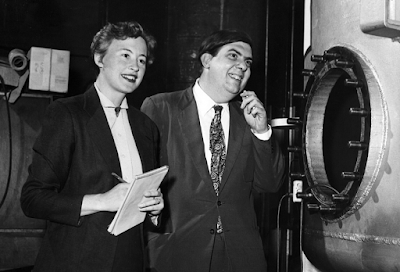 |
| Burbidge, pictured with her husband and research partner, Geoffrey, was appointed to numerous leadership positions previously held only by men. | W.W. Girdner/Caltech Archives |
Topics: Astronomy, Astrophysics, Diversity, Diversity in Science, Women in Science
Margaret Burbidge, a past president of the American Association for the Advancement of Science who overcame gender discrimination on the way to becoming one of the most influential astrophysicists of her time, died on April 5 at her home in San Francisco. She was 100.
In 1957, Burbidge was the lead author of a study detailing the chemical processes by which elements heavier than lithium, including the carbon and oxygen that drive life on Earth, are created inside stars. The origins of such elements were previously unknown, and the research paper is the foundation of current understanding of what astronomers now call stellar nucleosynthesis.
Later in her career, Burbidge was appointed to numerous leadership positions previously held only by men and helped develop the Faint Object Spectrograph, one of the original scientific instruments aboard NASA’s Hubble Space Telescope. The FOS team provided the first strong, observational evidence for the existence of a supermassive black hole in the core of another galaxy.
Eleanor Margaret Peachey was born in Davenport, England, on August 12, 1919. Her father was a chemistry lecturer in nearby Manchester, and her mother had been one of his students.
When Peachey was two, the family moved to London, where cloudy skies often prevented starlight from reaching the city.
“The first time I consciously remember really noticing the stars was the summer that I was four, and we were going on a night crossing to France for summer vacation,” Burbidge said in a 1978 interview with the American Institute of Physics. “These twinkling lights became another fascination to me.”
Aware of her interest in the stars, Peachey’s grandfather gave her books by English astronomer James Jeans for her 12th and 13th birthdays. By the age of 19, she had graduated with honors from University College London, where she studied astronomy, physics and mathematics. In 1943, she earned her Ph.D. from UCL.
After receiving her doctorate in the midst of World War II, Peachey continued to use the telescope at the UCL Observatory, sometimes with bombs exploding in the city around her. Hoping to work with better equipment and clearer skies, she applied for a fellowship that would have placed her at the Mount Wilson Observatory outside of Los Angeles.
“The turn-down letter simply pointed out that Carnegie Fellowships were available only for men,” Burbidge wrote in a 1994 memoir. “A guiding operational principle in my life was activated: If frustrated in one’s endeavor by a stone wall or any kind of blockage, one must find a way around — another route towards one’s goal. This is advice I have given to many women facing similar situations.”
In 1948, Peachey married Geoffrey Burbidge, a UCL graduate student in physics who soon switched fields to collaborate with his wife on her astronomy research. When Geoff applied for the same Carnegie Fellowship, he was accepted, and Margaret took a position at the California Institute of Technology in Pasadena. When they needed to use the Mount Wilson telescope, the couple would arrive with Margaret posing as her husband’s assistant.
In Memoriam:
Margaret Burbidge, Pioneering Astronomer and Advocate for Women in Science
Adam D. Cohen, American Association for the Advancement of Science
Comments